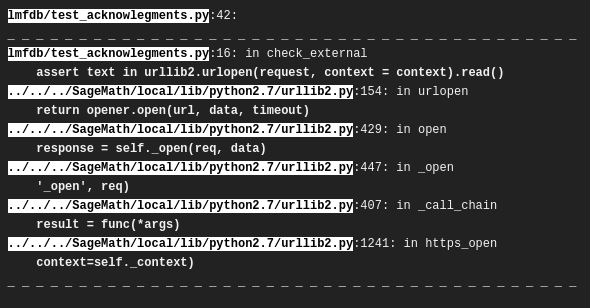In my previous post, I noted that the ability to see in color gave me an apparent superpower in quickly analyzing Travis CI and pytest logs.
I wondered: how hard is it to use colorblind friendly colors here?
I had in the back of my mind the thought of the next time I sit down and pair program with someone who is colorblind (which will definitely happen). Pair programming is largely about sharing experiences and ideas, and color disambiguation shouldn't be a wedge.
I decided that loading customized CSS is the way to go. There are different ways to do this, but an easy method for quick replicability is to create a bookmarklet that adds CSS into the page. So, I did that.
You can get that bookmarklet here. (Due to very sensible security reasons, Wordpress doesn't want to allow me to provide a link which is actually a javascript function. So I make it available on a static, handwritten page).1 1I suppose one could interpret this as a not so subtle hint that javascript injection can be unsafe. Fortunately this bookmark is very transparent.
Here's how it works. A Travis log looks typically like this:
After clicking on the bookmarklet, it looks like
 This is not beautiful, but it works and it's very noticable. Nonetheless, when the goal is just to be able to quickly recognize if errors are occuring, or to recognize exceptional lines on a quick scroll-by, the black-text-on-white-box wins the standout crown.
This is not beautiful, but it works and it's very noticable. Nonetheless, when the goal is just to be able to quickly recognize if errors are occuring, or to recognize exceptional lines on a quick scroll-by, the black-text-on-white-box wins the standout crown.
The LMFDB uses pytest, which conveniently produces error summaries at the end of the test. (We used to use nosetest, and we hadn't set it up to have nice summaries before transitioning to pytest). This bookmark will also effect the error summary, so that it now looks like
 Again, I would say this is not beautiful, but definitely noticeable.
Again, I would say this is not beautiful, but definitely noticeable.
As an aside, I also looked through the variety of colorschemes that I have collected over the years. And it turns out that 100 percent of them are unkind to colorblind users, with the exception of the monotone or monochromatic schemes (which are equal in the Harrison Bergeron sense).
We should do better.

Info on how to comment
To make a comment, please send an email using the button below. Your email address won't be shared (unless you include it in the body of your comment). If you don't want your real name to be used next to your comment, please specify the name you would like to use. If you want your name to link to a particular url, include that as well.
bold, italics, and plain text are allowed in comments. A reasonable subset of markdown is supported, including lists, links, and fenced code blocks. In addition, math can be formatted using
$(inline math)$or$$(your display equation)$$.Please use plaintext email when commenting. See Plaintext Email and Comments on this site for more. Note also that comments are expected to be open, considerate, and respectful.